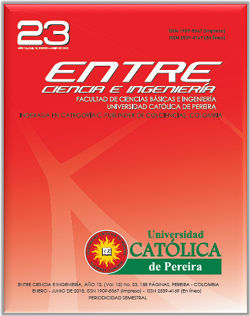Incidence of the teacher’s metaphorical discourse in the teaching of the complex number concept
DOI:
https://doi.org/10.31908/19098367.3712Keywords:
Discourse analysis, metaphorical language, complex number, Cognitive Theory of MathematicsAbstract
In this paper, it is presented two math teachers’ discourse analysis results, to identify the possible incidence of the metaphorical language used by them, in the learning of the concept of a complex number with ninth grade students. The analysis of the metaphorical language of the teacher is done in the light of the Cognitive Theory of Mathematics. It seeks the understanding of mathematics in the metaphorical thinking of people, and not in the rigorous demonstrations of books, emphasizing the connection that has the body with the cognitive processes, inducing the main key for the reform of teaching and learning processes focused on mathematical communication.
References
Rojas, V. “Incidencia del lenguaje metafórico empleado por el docente en el aprendizaje del concepto de número complejo con estudiantes de grado noveno de la institución educativa Hogar Nazaret de Dosquebradas”. Tesis de maestría, Facultad de Ciencias Básicas, Universidad Tecnológica de Pereira, 7 oct. 2017.
Lakoff, G., Johnson, M. Metáforas de la vida cotidiana, 2da. edición, Madrid: Cátedra, 1995. Disponible: https://linguisticaunlp.files.wordpress.com/2012/11/lakoff-y-johnson.pdf.
Lizcano, E. Metáforas que nos Piensan. Sobre Ciencia, Democracia y otras Poderosas Ficciones. Ediciones Bajo Cero, bajo licencia de Creative Commons, 2006.
Vázquez, R. (2007). Las metáforas: Una vía posible para comprender y explicar las organizaciones escolares y la dirección de centros. REICE, vol. 5, No. 3, pp. 137-51. Disponible en: http://rinace.net/arts/vol5num3/art14.pdf.
Font, V., Acevedo, J.L. “Fenómenos relacionados con el uso de metáforas en el discurso del profesor. El caso de las gráficas de funciones,” en Enseñanza de las Ciencias, 21(3), pp. 405-4018, 2003.
Lakoff, G., Nuñez, R. Where mathematics comes from: How the embodied mind brings mathematics into being. New York. Basic Books, 2000.
Pimm, D. El lenguaje matemático en el aula. (3ra ed.). Madrid: Morata, 2003.
Chevallard, I. La transposición didáctica. Del saber sabio al saber enseñado. 3a Ed. Psicología cognitiva y Educación. Buenos Aires: AIQUE, 1998.
Castoriadis, C. El imaginario social instituyente. Trad. Luciana Volco. En Revista Zona Erógena No. 35, 1997. Disponible: http://www.ubiobio.cl/miweb/webfile/media/267/Castoriadis%20Cornelius%20- [%20El%20Imaginario%20Social%20Instituyente.pdfL
Godino, J., Batanero, C. Significado institucional y personal de los objetos matemáticos. En Recherches en Didactique des Mathemétiques, vol. 14, no. 3, pp. 325-55, 1994. Disponible: http://www.ugr.es/~jgodino/funciones-semioticas/03_SignificadosIP_RDM94.pdf.
Cohen, L., Manion, L., Morrison, K. Research methods in education, Londres, Routledge, 2011, 638p.
Navarro, P., Díaz, C. Análisis de contenido, en Delgado, J. M, y Gutiérrez, J. (coordinadores): Métodos y técnicas cualitativas de investigación en ciencias sociales. Madrid: Síntesis, 1999.
Mahl, G.F. Exploring emotional states by content analysis. En I. Pool (Ed.), Trends in content analysis, Urbana, IL: University of Illinois Press, 1959, pp. 89-130.
Hernández, S.R., Fernández, C., Baptista, P. Metodología de la investigación. México, D. F., McGraw Hill-Iberoamericana, 2006.
D’Ambrosio. U. Etnomatemática. Eslabón entre las tradiciones y la modernidad. México D. F.: Limusa/Cideccyt, 2008.
Brousseau, G. Fundamentos y métodos de la Didáctica. En Trabajos de Enseñanza No. 5: Trad. Dilma Fregona. Córdoba, Argentina: Universidad Nacional de Córdoba, 2014.
Hoffmann, M. Matemáticas: Fórmulas, reglas y reglas mnemotécnicas. México: Alfaomega, 2013, 384p.








 Revista Entre Ciencia e Ingeniería
Revista Entre Ciencia e Ingeniería .png) entrecei@ucp.edu.co
entrecei@ucp.edu.co.png) ISSN (Impreso) 1909-8367 - ISSN (En Línea) 2539-4169
ISSN (Impreso) 1909-8367 - ISSN (En Línea) 2539-4169 Attribution-NonCommercial 4.0 International (CC By-NC 4.0)
Attribution-NonCommercial 4.0 International (CC By-NC 4.0)
.png) Carrera 21 No. 49-95 Av. de las Américas, Pereira, Risaralda, Colombia
Carrera 21 No. 49-95 Av. de las Américas, Pereira, Risaralda, Colombia